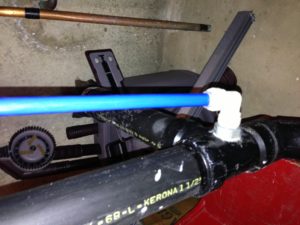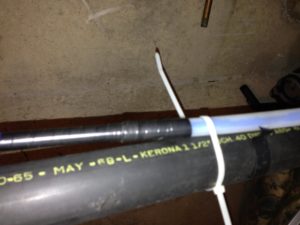Can Iron Filter And Softener Drain Lines Be Tied Together
One of the most important components of a proper softener installation is provision for safe drainage by avoiding a possible "cross connection". A cross connection is whatsoever signal at which a h2o supply pipe or container is joined directly to a sewer piping. It is at this point lone that information technology is even remotely possible for a water softening/conditioning arrangement to introduce a take chances to a household. This can not happen if safe drainage is provided by using a sufficient air gap in the installation. NEVER Brand A Cross CONNECTION.
There are very simple reasons why a water handling system must never be connected directly to a sewer pipe:
Consider a water treatment system installed with a straight drain connection to the sewer organization, that is a cantankerous connectedness. If, during the regeneration bike there is a fire in the vicinity. What would happen if the firemen'due south pumping equipment creates such a strong need for water that suction occurs and information technology actually causes h2o to flow from the house dorsum into the primary line? Actually, if the suction were strong enough, some fluid from sewer pipes might be drawn dorsum through the h2o treatment system and back out into the water supply lines. The danger is that sewage containing potentially pathogenic organisms could then be introduced into the water supply.
Patently, the public health and the private welfare of your household must be at the uppermost consideration in the mind of the installer at all times. This is why the air gap rule must always be followed for drainage installations.
A softener bleed line must not be connected direct to the waste system, only must be emptied into a laundry tray, flooring drain, or properly trapped special outlet, preserving an air gap of at least two times the diameter of the drain line, but in no case less than 1-one/ii″ to a higher place the top of the receptacle used. The greater of two and a half times the diameter of the equipment'southward indirect drain or one-1/two″ is the minimum air gap for whole business firm (point-of-entry) water treatment equipment. The greater of ii.five times the equipment constructive drain line diameter, or one inch, is immune for bespeak-of-apply equipment. In add-on, the end of the drain line should be secured so that there is no chance that it can become immersed in waste fluids.
Exist sure to written report and follow the equipment manufacturer's installation instructions. They will specify bleed line size. If the proper size is non provided, the unit may not exist properly backwashed.
Type Of Drain Required
A laundry sink or any other sink can serve satisfactorily as an emptying identify for the drain line, but it's ever best to discharge to the sewer whenever possible.
A trap installed in a waste line will also suffice, providing in that location is a proper air gap or vacuum breaker betwixt the tap and the drain line from the softener.
A funnel organisation may also be advantageously used in such an installation. A floor drain may also exist used if it is out of the way of traffic. Rigid pipe should exist used and positioned so that the minimum air gap cannot be reduced by moving the pipe. When the water treatment system is supplied with flexible drain line cloth, the bleed must be tightly secured in the correct position to avert deliberate or adventitious motion.
Some units provide an overflow drain line for the regenerant container. Such a line should be run to a floor drain. It must run past gravity feed to a lower bleed.
Never EVER install a drain similar this:

It gets worse (at the same installation):

Can Iron Filter And Softener Drain Lines Be Tied Together,
Source: http://gregknowswater.com/residential-water-softener-drain-installation-tips/
Posted by: brittfecid1988.blogspot.com


0 Response to "Can Iron Filter And Softener Drain Lines Be Tied Together"
Post a Comment